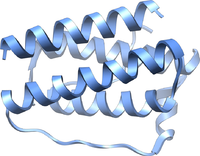
Photo from wikipedia
BackgroundClinical variables may correlate with lack of response to treatment (primary resistance) or clinical benefit in patients with clear cell renal cell carcinoma (ccRCC) treated with anti-programmed death 1/ligand one… Click to show full abstract
BackgroundClinical variables may correlate with lack of response to treatment (primary resistance) or clinical benefit in patients with clear cell renal cell carcinoma (ccRCC) treated with anti-programmed death 1/ligand one antibodies.MethodsIn this multi-institutional collaboration, clinical characteristics of patients with primary resistance (defined as progression on initial computed tomography scan) were compared to patients with clinical benefit using Two sample t-test and Chi-square test (or Fisher’s Exact test). The Kaplan–Meier method was used to estimate the distribution of progression-free survival (PFS) and overall survival (OS) in all patients and the subsets of patients with clinical benefit or primary resistance. Cox’s regression model was used to evaluate the correlation between survival endpoints and variables of interest. To explore clinical factors in a larger, independent patient sample, The Cancer Genome Atlas (TCGA) was analyzed. RNAseq gene expression data as well as demographic and clinical information were downloaded for primary tumors of 517 patients included within TCGA-ccRCC.ResultsOf 90 patients, 38 (42.2%) had primary resistance and 52 (57.8%) had clinical benefit. Compared with the cohort of patients with initial benefit, primary resistance was more likely to occur in patients with worse ECOG performance status (p = 0.03), earlier stage at diagnosis (p = 0.04), had no prior nephrectomy (p = 0.04) and no immune-related adverse events (irAE) (p = 0.02). In patients with primary resistance, improved OS was significantly correlated with lower International Metastatic RCC Database Consortium risk score (p = 0.02) and lower neutrophil:lymphocyte ratio (p = 0.04). In patients with clinical benefit, improved PFS was significantly associated with increased BMI (p = 0.007) and irAE occurrence (p = 0.02) while improved OS was significantly correlated with overweight BMI (BMI 25–30; p = 0.03) and no brain metastasis (p = 0.005). The cohort TCGA-ccRCC was examined for the correlations between gene expression patterns, clinical factors, and survival outcomes observing associations of T-cell inflammation and angiogenesis signatures with histologic grade, pathologic stage and OS.ConclusionsClinical characteristics including performance status, BMI and occurrence of an irAE associate with outcomes in patients with ccRCC treated with immunotherapy. The inverse association of angiogenesis gene signature with ccRCC histologic grade highlight opportunities for adjuvant combination VEGFR2 tyrosine kinase inhibitor and immune-checkpoint inhibition.
Journal Title: Journal of Translational Medicine
Year Published: 2019
Link to full text (if available)
Share on Social Media: Sign Up to like & get
recommendations!